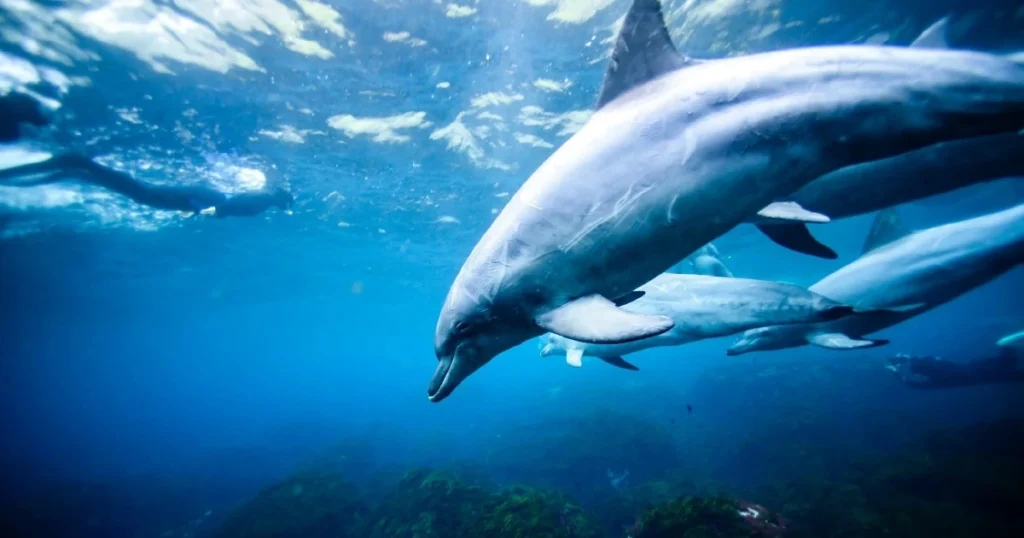
Few creatures capture the human imagination in marine fascination quite like dolphins. Their intelligence, grace, and seemingly playful nature have endeared them to many. However, amidst the admiration and wonder, a question often arises: Do dolphins attack humans?
As intelligent mammals, Dolphins exhibit complex behaviors shaped by their environment, social structure, and instincts. While interactions between humans and dolphins are typically peaceful and mutually beneficial, instances of aggression or perceived attacks have been reported.
There aren’t many dolphin attacks per year, yet despite their generally docile nature, dolphins are capable of aggression, as observed in various contexts. One notable scenario is during feeding times, where resource competition may lead to aggressive behavior, including biting or ramming. Additionally, territorial disputes or perceived threats to calves can provoke defensive responses from dolphins.

Several factors may contribute to instances of dolphin aggression toward humans. Environmental stressors such as pollution, habitat degradation, or disturbances from human activities can disrupt natural behaviors and potentially escalate tensions. Similarly, improper interactions initiated by humans, such as attempts to touch or feed wild dolphins, can elicit defensive reactions.
Discerning between playful behaviors and actual aggression when encountering dolphins is essential. While activities like bow-riding or playful nudges are common and harmless, signs of aggression, such as aggressive posturing, vocalizations, or forceful contact, should be approached cautiously.
Responsible practices should be emphasized to minimize the likelihood of negative interactions between humans and dolphins. This includes respecting natural boundaries, avoiding direct contact with wild dolphins, and refraining from feeding or attempting to interact with them in their natural habitat.
Beyond addressing aggression concerns, fostering public awareness and appreciation for dolphin conservation is paramount. Efforts to protect marine ecosystems, reduce human impact on dolphin habitats, and promote responsible tourism can contribute to the long-term well-being of these remarkable creatures.
Delving deeper into dolphin behavior unveils a myriad of intricacies. These marine mammals exhibit remarkable intelligence, social bonds, and communication skills, which shape their interactions with their environment and other species, including humans.
Central to dolphin sociality is their sophisticated communication system. Dolphins emit a diverse array of vocalizations, ranging from whistles and clicks to complex sequences of sounds. These vocalizations serve various purposes, including coordinating group movements, establishing social bonds, and conveying emotional states.

Dolphins have evolved a suite of adaptations that enable them to thrive in their aquatic habitat. Their streamlined bodies, hydrodynamic shapes, and efficient swimming techniques facilitate swift navigation through the water. Additionally, specialized sensory organs, such as echolocation, aid in locating prey and navigating the underwater landscape.
Dolphins exhibit remarkable behavioral flexibility in response to environmental changes and anthropogenic impacts. They may adjust their feeding strategies, migration patterns, or social dynamics to cope with shifting conditions. However, such adaptability is not limitless, and persistent threats, such as habitat destruction or pollution, can pose significant challenges to dolphin populations.
Protecting dolphin populations is a global imperative given their ecological and cultural significance. Conservation efforts encompass various strategies, including establishing marine protected areas, implementing sustainable fishing practices, and mitigating human-induced threats. We can secure a future where these majestic marine mammals thrive by safeguarding dolphin habitats and promoting coexistence with humans.
Critter Stop has a fantastic reputation, and customer reviews online because it provides high-quality work and great customer service. For those facing issues with wildlife or pest removal from their property, calling Critter Stop at (214) 234-2616 for a free inspection is the first step towards resolving the problem effectively and humanely.
As experts in wildlife management, we at Critter Stop understand the importance of dispelling myths and providing accurate information about animal behavior. Here are answers to common questions regarding dolphin behavior:
While rare, dolphins are capable of aggressive behavior, typically in response to perceived threats or disturbances. Understanding their natural behaviors and respecting their space can help minimize the risk of negative encounters.
Exact statistics on dolphin attacks are difficult to determine due to underreporting and varying definitions of what constitutes an "attack." However, documented instances are relatively low compared to interactions with other wildlife species.
Dolphin aggression can be triggered by various factors, including competition for resources, territorial disputes, or stress from human interactions. Understanding these triggers can help mitigate potential conflicts and promote responsible coexistence.
Responsible interactions with dolphins involve maintaining a respectful distance, refraining from feeding or attempting to touch them and avoiding behaviors that may disrupt their natural behaviors. Observing from a distance and allowing dolphins to approach on their terms fosters positive interactions while minimizing animal stress.
Visit our Critter Library and learn more about our furry friends